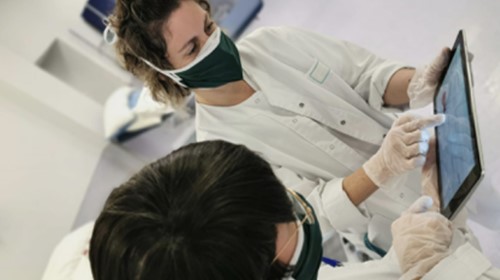Interactive Clinics ( www.interactiveclinics.com ) has made the platform developed jointly by the University of Manresa UVic-UCC, the Bit Genoma company and the University of Newcastle (Australia) available to the healthcare system. This application has previously been used to monitor the evolution of pain, adherence to the prescribed treatment, and the systematic monitoring of signs and symptoms of diseases such as type 2 diabetes and rheumatoid arthritis.
Integration with LifeVit devices has facilitated remote monitoring of patients in an automated way, the professional can see all the biometrics associated with the patient within the interactive clinics platform in a reliable and safe way.
Since the beginning of the epidemic, exhaustive work has been done to include functionalities in the platform and the Interactive Clinics COVID-19 module facilitates self-evaluation through the test recommended by the WHO, allows linking the data provided by patients with the systems of triage of health organizations to activate alarms in case of detecting clinical changes, and facilitates communication between patients and staff through the video consultation application.
The updated version of the App that has been made available to the health system for free to respond to the need generated by the pandemic can be downloaded from Google Play and the Apple Store. The results were released on April 6, when patients with contagious symptoms from the EBA Centelles primary care center became the first COVID-19 patients to be tele-monitored through Interactive Clinics.
More than 15% of Healthcare personnel in Spain have presented symptoms associated with COVID-19. Hence the importance of having tools that maximize the capacity for assistance by facilitating self-assessment and remote patient monitoring, which in addition to reducing the risk of contagion enables the integration of medical professionals from other autonomous communities, retired professionals, and even health professionals with mild symptoms who will be able to continue assisting patients from their homes.
During the deconfinition, the application will be a great ally to continue with the supervision of patients who, after overcoming critical conditions, are discharged, as well as detect possible new infections and monitor both patients with different levels of criticality associated with COVID-19 and people diagnosed with pathologies prior to the pandemic. The information provided by patients is guarded to ensure that their identity is only accessible to the doctor who does the monitoring .
Approximately one hundred elderly people, most with concomitant chronic diseases in central Catalonia, one of the areas with the largest aging population affected by COVID-19, will be able to be monitored through Interactive Clinics thanks to the donation of 75 SIMs by Vodafone that will be distributed among those people who have no connection together with tablets that have been provided by the Manresa campus of the UVic-UCC.
Interactive Clinics was conceived with the objective of facilitating access to medical care and clinical follow-up. The first module integrated into the platform was the Pain level based on the VAS visual analog scale, the reference measure to perform a reliable self-report. To demonstrate that responding to the pain scale on a touch screen had the same validity as doing it on paper, a two-year study was conducted in which the eVAS was shown to have the same validity as the traditional pVAS . This study was published last February in the prestigious scientific journal Journal of Medical Internet Research (JMIR).
Driven by the desire to respond to the needs of COVID-19 in Central Catalonia, the Interactive Clinics application has managed to develop new interactive modules and consolidate its telemedicine tools for the continuous monitoring of patients from a distance, the acquisition of so-called ” patient reported outcomes ”(result reported by the patient) and enable a private and reliable communication channel between patient and health professionals.
When the pandemic has finally been controlled, the use of ICT will allow organizations to have better tele-capacity infrastructures on which to evolve, as well as to have useful information to face future crises.

